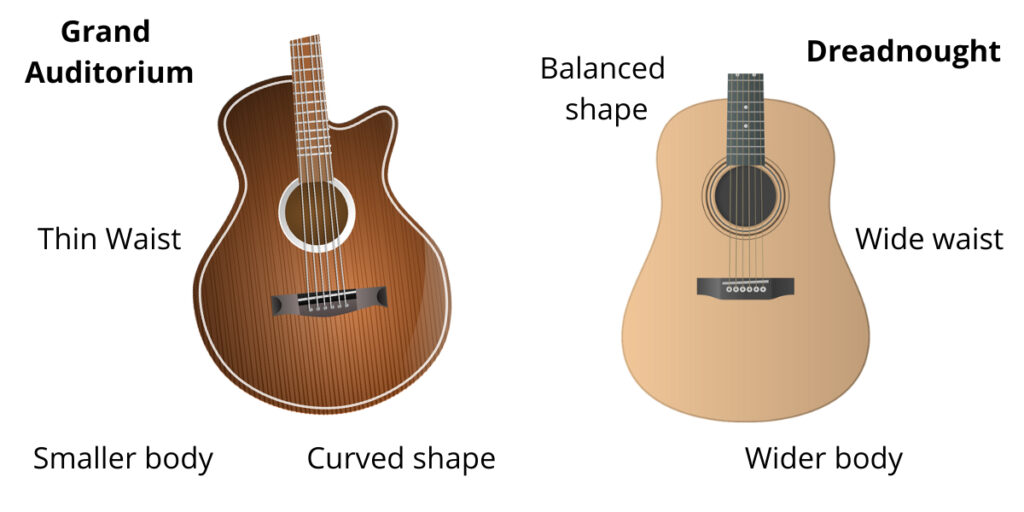The Taylor 100 series offers a great introduction to the brand. Two of the most popular guitars in this series are the 110e and 114e which share many of the same features but look, feel and sound pretty different from one another due to their body shapes.
In this article, I’ll directly compare the 110e and 114e to help you decide which acoustic guitar is most suitable for your style.
Quick Comparison
The Taylor 110e and 114e both have solid spruce tops and laminate walnut back and sides, however they have different body shapes. The 110e has a dreadnought shape which causes it to sound warmer and louder, whereas the 114e has a grand auditorium shape which makes it sound brighter.
Body Shape and Size
The differences in feel and tone between these two acoustic guitars is caused by the body shapes.
- The Taylor 110e has a dreadnought body
- The Taylor 114e has a Grand Auditorium body
Dreadnoughts have a balanced shape and are quite large due to their wider waist, whereas Grand Auditorium guitars have a curvier shape with a shallower waist so are smaller overall.

The 110e and 114e have the same body depth, length and maximum width. The main dimension that varies between the two guitars is the waist dimension.
- The 110e’s waist measures 11.06″
- The 114e’s waist measures 9.63″
Tone Comparison
The shape of these two Taylor’s has a huge impact on the tone.
The Taylor 110e has a dreadnought shape which produces a lot of bass and scoops the mid-range slightly. This is a similar frequency where the human voice sits, making the guitar a popular choice with singers because it means their voice can be heard clearly, without having to compete with the guitar.
The Taylor 114e’s shape causes the treble to be more pronounced and gives the guitar a brighter tone in comparison to the 110e which sounds warmer. In terms of volume, the 110e is slightly louder than the 114e since it has a larger body size due to its shallow waist.
Dreadnoughts are considered quite versatile but really excel at strumming. Grand auditorium guitars sound a bit more delicate and are more suitable to fingerstyle, but still can be used for strumming.
When plugged in, you’ll notice similar characteristics as both guitars use the same pickup (Taylor’s Expression 2 system). Both guitars also have spruce tops and walnut back and sides, so it’s only the body shape which makes a difference here.
Check out this YouTube video to hear the Taylor 110e and 114e being played back-to-back so you can hear the differences.
Feel and Playability
Some players prefer the Grand Auditorium body shape found on the 114e due to its narrower waist which makes it easier to play whilst sitting down as it rests more comfortably on the knee. The dreadnought can feel quite large and for some smaller players in particular, it can feel a little awkward.
It’s tough to say which feels the best as it is very subjective. I personally find the shape of the 114e a bit more manageable and comfortable but there will be many players out there who prefer a dreadnought. I recommend trying these guitars out in the store to help you make your decision.
Don’t worry if the store doesn’t have the 110e and 114e in stock. Any Taylor guitar with a 3-digit number that ends in “0” is a dreadnought and any that ends in a “4” is a grand auditorium so you should be able to find one to try to assess how comfortable it feels.
Another thing to note is the string gauge.
- The Taylor 110e comes with medium strings
- The Taylor 114e comes with light strings
The 110e may feel a bit harder to play if you’re a beginner due to the thicker strings which have more tension. However, you can always switch out the strings for a lighter gauge if you’re finding them to be a problem.
Equally, you can put some heavier strings on the 114e to improve tuning stability and increase the volume.

Similarities
Since both these guitars are in the 100 series, they share many of the same features. Here’s a list of the main similarities between the 110e and 114e:
- Solid spruce top
- Layered walnut back and sides
- Maple neck
- Ebony fretboard
- X-braced
- Expression System 2 pickup
- Body length, depth and maximum width (lower bout)
- 25.5″ scale
- 1.69″ nut width
- 15″ fingerboard radius
- Varnish finish
- Tusq nut and micarta saddle
- Rosette and pickguard design
- Tuning machines
- Both come with a gig bag
Full Specification List
| Specification | Taylor 110e | Taylor 114e |
| Shape | Dreadnought | Grand Auditorium |
| Top Material | Solid Sitka Spruce | Solid Sitka Spruce |
| Back and Sides Material | Layered Walnut | Layered Walnut |
| Neck Material | Maple | Maple |
| Fretboard Material | Ebony | Ebony |
| Bracing | X-Bracing | X-Bracing |
| Pickup | Expression System 2 | Expression System 2 |
| Body Length | 20” | 20” |
| Body Depth | 4.63” | 4.63” |
| Lower Bout Width | 16” | 16” |
| Waist Width | 11.06” | 9.63” |
| Scale | 25.5” | 25.5” |
| Nut Width | 1.69” | 1.69” |
| Fingerboard Radius | 15” | 15” |
| Heel Length | 3.5” | 3.5” |
| Body and Neck Finish | Varnish | Varnish |
| Tuning Machines | Chrome | Chrome |
| Strings | Bronze Medium | Bronze Light |
| Nut | TUSQ | TUSQ |
| Saddle | Micarta | Micarta |
| Pickguard | Black Plastic | Black Plastic |
| Truss Rod Cover | Black Plastic | Black Plastic |
| Rosette | 3 Ring Plastic | 3 Ring Plastic |
| Peghead Logo | Taylor Colorcore | Taylor Colorcore |
| Case | Gig Bag | Gig Bag |
If you want to check the current prices of these guitars, here are links to Guitar Center:
Check out my comparison between the Taylor 114 and 214.


